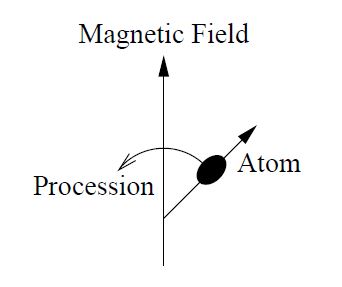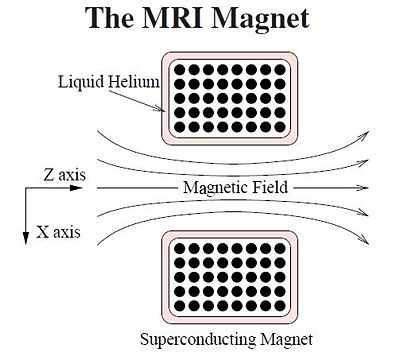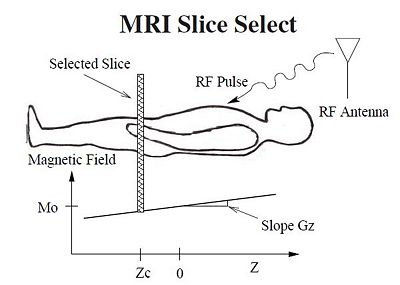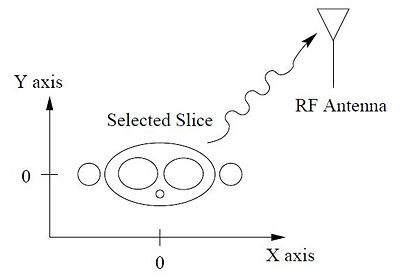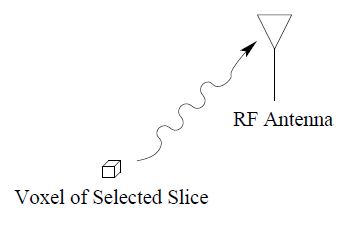| Line 84: | Line 84: | ||
---- | ---- | ||
=Signal Analysis on a Single Voxel= | =Signal Analysis on a Single Voxel= | ||
| + | [[Image: MRI_singlevoxel.jpg|400px|thumb|left|Fig 5: Single Voxel Signal Analysis]] | ||
| + | First the signal will be analyzed for a single voxel, then it will be scaled up to calculating every voxel in a slice. Because the calculation is being performed in a single slice, <math>z</math> is considered a constant. | ||
| + | The RF signal from a single voxel has the form<br /> | ||
| + | <math>r(x,y,t) = f(x,y)e^{j\phi (t)} \ </math><br /> | ||
| + | <math>f(x,y)</math> is the quantity of interest that is dependent on the properties of the material in the voxel and a weighting (T1,T2 or T2*)<br /> | ||
| + | <math>\phi (t)</math> is the phase of the received signal. This term can be modulated using <math>G_x</math> and <math>G_y</math>. Also, without loss of generality, we assume that <math>\phi (0) = 0</math>. | ||
---- | ---- | ||
=Scaling Signal Analysis to a Slice= | =Scaling Signal Analysis to a Slice= | ||
Revision as of 00:10, 22 December 2014
Magnetic Resonance Imaging (MRI)
A slecture by ECE student Sahil Sanghani
Partly based on the ECE 637 material of Professor Bouman.
Contents
- 1 Introduction
- 2 Magnetic Resonance
- 3 MRI Hardware
- 4 Magnetic Field Gradients
- 5 MRI Slice Selection
- 6 Slice Selection Pulse Design
- 7 Image the Selected Slice
- 8 Signal Analysis on a Single Voxel
- 9 Scaling Signal Analysis to a Slice
- 10 K-Space
- 11 Echo Planar Imaging (EPI) Scan Pattern
- 12 EPI Reading Spacings
Introduction
Magnetic Resonance Imaging (MRI) is a different mode of imaging from the previously discussed ones. It is characterized by using changing magnetic fields and RF waves to selectively resonate areas of interest for imaging. MRI does not use ionizing radiation like CT does, and it is very flexible and adaptable. It can be reprogrammed to fit specific needs. It is also very high in resolution with normal scans having a resolution on the order of millimeters. Theoretically the only bound on the resolution is the length of the scan. This quality has its trade-offs. MRI is very expensive and the length of the scan is long. A big superconducting magnet, which is very expensive, is needed. Despite these drawbacks, MRI has many different uses. It can be used for conventional anatomical scans, as a functional imaging modality (oxygen activity levels in the brain), and as other modalities.
Magnetic Resonance
Atoms that have a magnetic dipole process around the magnetic field's axis, not unlike how a top takes a wider rotation as slows down. Figure 2 shows how these atoms process.
Different atoms have different procession frequencies, which is called the Lamor Frequency, based on intrinsic qualities and the surrounding magnetic field. Hydrogen is the typical atom of focus in conventional MRI scanners due to its ubiquity in the water contained in the soft tissue of the body. At a magnetic field strength of 1.5T, the Lamor frequency for H is 63 MHz.
Let
$ M: $= magnitude of the magnetic field
$ \omega_0: $= the frequency of procession (Lamor frequency)
$ L: $= Lamor constant, which is an intrinsic atomic quality
The Lamor frequency is defined as
$ \omega_0 = LM \ $
The procession can resonate with an RF signal targeted at the atom if the RF signal is at the center frequency of procession. Once the RF signal is removed, the atom will radiate RF energy until the energy is lost. The sensitivity of procession to magnetic field is used to selectively choose slices for analysis, and the RF energy emission is used to create pinpoint specific nuclei of interest. This data makes up the projections used in reconstruction.
MRI Hardware
Clinically high strength magnetic fields are used for imaging because ensure good resolution. Also, the radius of the bore where the patient enters the scanner is relatively large, so stronger fields are needed to compensate. In order to generate these large magnetic fields, superconducting magnets are used.
Superconducting magnets are metals whose resistance is 0$ \Omega $ when they are cooled to below a threshold temperature. Liquid helium is used to achieve these low temperatures, which are around a few degrees Kelvin. Because Helium is the lightest noble gas, it is the lightest and one of the faster moving inert substances. It is so energetic that it only changes phase at extremely low temperatures. At normal pressures, solid helium doesn't even exist because it is impossible for the atoms to be fixed in an ordered structure.
Once electric current is injected into the superconducting magnet by a generator, it continuously flows. Because there is no resistance, the amount of current doesn't decrease and just keeps flowing even when the generator is disconnected. The orientation of all the elements in the magnetic field generation is shown in Figure 3.
Over time some of the liquid helium will boil off, and leave the superconducting magnet exposed. This is an event known as "quenching." As the superconducting magnet is left exposed, it warms up and gains a little resistance. This little resistance starts a vicious cycle of heat dissipation and further helium boiled off. This exponential increase in helium converting to gas can be destructive, so the magnets have to be designed accordingly.
Magnetic Field Gradients
For our purposes, we will assume that the magnetic field created by the superconducting magnet is a scalar ($ M_o $) with a position independent yet adjustable magnitude as opposed to a vector. This is assumption is made because the field within the bore should be flowing in a fixed direction.
On top of having the superconducting magnet, there are magnetic gradient coils that can slightly alter the field withing the bore. The gradient coils are designed so that the magnetic field changes linearly with position, and they are controlled through amplifiers. These gradients go along each axis, and are named $ G_x $, $ G_y $ and $ G_z $. Thus the magnetic field magnitude at the location $ (x,y,z) $ can be expressed as
$ M(x,y,z) = M_o + xG_x + yG_y + zG_z \ $
For the time changing gradients the expression can be adapted as follows
$ M(x,y,z,t) = M_o + xG_x(t) + yG_y(t) + zG_z(t) \ $
The current through each of the three coils, one for each axis, enable a gradient to be created/adjusted along each axis.
MRI Slice Selection
For this explanation, assume that the $ G_x=G_y=0 $. We will have a positive gradient from $ G_z $ as shown in Figure 4.
Now if an RF pulse at 63MHz is sent to the body, protons whose resonant frequency matches the RF frequency will resonate. Because there is a magnetic gradient, the atoms at different values of $ z $ have different resonant frequencies. Changing the frequency of the RF pulse would allow the targeting of specific values of $ z $. Because all the H atoms at a specific value of $ z $ will have the same magnetic field, they would all be targeted by a specific RF frequency. This group makes up the "slice" of the person being selectively excited.
Essentially the resonance frequency of the H atoms is given by
$ \omega = L(M_o + zG_z) \ $
Slice Selection Pulse Design
The width and location of the desired slice can be modified by the characteristics of the pulse emitted by the RF antenna. In order to send the pulse, it needs to be modulated onto a carrier wave. This modulation causes the frequency response of the RF signal to be a shifted rect. The shift is determined by the carrier wave, and the width of the slice corresponds the the width of the rect.
There are 2 design parameters:
$ z_c: $= slice center, controlled by the carrier frequency
$ \delta z: $= slice thickness, controlled by the width of the sinc pulse
To focus on the slice centered at $ z_c $, the pulse frequency is given by
$ f_c = \frac{LM_o}{2\pi}+\frac{z_cLG_z}{2\pi} = f_0 + \frac{z_cLG_z}{2\pi} $
The pulse bandwidth can be calculated from the slice thickness $ \Delta z $
$ BW = \frac{\Delta z LG_z}{2\pi} $
Using the parameters $ f_c $ and $ BW $, the pulse is given by
$ p(t) = e^{j2\pi f_ct}sinc(tBW) $
and its CTFT is given by
$ P(f) = rect(\frac{f-f_c}{BW}) $
Image the Selected Slice
Previously we saw how to target a specific slice, but just recording the volume of RF emission from a total slice isn't useful for getting precise reconstruction. The strategy is to vary magnetic gradients $ G_x $ and $ G_y $. This varying will create voxels with individual RF emission amounts that can be compiled into an overall density map of the slice.
Signal Analysis on a Single Voxel
First the signal will be analyzed for a single voxel, then it will be scaled up to calculating every voxel in a slice. Because the calculation is being performed in a single slice, $ z $ is considered a constant.
The RF signal from a single voxel has the form
$ r(x,y,t) = f(x,y)e^{j\phi (t)} \ $
$ f(x,y) $ is the quantity of interest that is dependent on the properties of the material in the voxel and a weighting (T1,T2 or T2*)
$ \phi (t) $ is the phase of the received signal. This term can be modulated using $ G_x $ and $ G_y $. Also, without loss of generality, we assume that $ \phi (0) = 0 $.
Scaling Signal Analysis to a Slice
K-Space
Echo Planar Imaging (EPI) Scan Pattern
EPI Reading Spacings
Put your content here . . .
References:
[1] C. A. Bouman. ECE 637. Class Lecture. Digital Image Processing I. Faculty of Electrical Engineering, Purdue University. Spring 2013.


